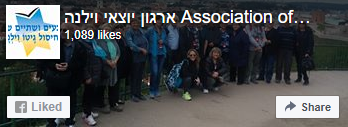"We Are Here" Folk Group
Anachnu Kan is the Jewish folklore ensemble that represents Tel Aviv and Israel overseas. The ensemble was founded in 1956 in Vilna, the capital of Lithuania, U.S.S.R. When the gates from Russia were opened in the 70s, the members of the ensemble were among the first to immigrate to Israel, and within a short time, had renewed their activities in Israel under the Hebrew name Anachnu Kan (in Yiddish: Mir Zeinen Do). From its inception, its aim was to preserve and disseminate Judeo-Israeli folklore culture. The ensemble's repertoire is based on a blend of Oriental and Western cultures: song and dance of Spanish Jewry, Eastern Europe, Yemen, Morocco and the Mediterranean Basin, young and old (a stable choir as against young dancers), the old and the new, the sabra (native-born Israelis) as against the Diaspora.
The ensemble was founded in Vilna in 1956 as a framework for groups of artists, singers, dancers and actors who wished to preserve the Jewish cultural heritage after the annihilation of a sizable portion of the nation during the Holocaust.A group of Jews met secretly in Vilna and decided to embark on a campaign against the Russian authorities in order to try and revive the Jewish spirit in the city.
The group included Moshe Pianko, chairman of the committee and artistic director; Mark Moises, Assistant Committee Chairman and Artistic Officer; Hirsch Sharfshtein, lead actor of the drama circle; Moshe Wismonski, the ensemble's painter, and other personalities, including Shlomo Meirovich (conductor of the orchestra), Yitzhak Dogim (director, drama class), thespians: Motyl Kanowitz, Yuli Katz, Sara Becker, Zina Sharfshtein and others. The group turned to Berl Cesarkas, a violinist in the Philharmonic Orchestra of Lithuania , who made an application to the chairman of the Central Committee of Trade Unions in Lithuania and convinced him that a group of Jews in an amateur dramatic group would not be a pernicious influence . Shaul Blecharovitz , the conductor of the choir, Zhenya Rabinovich, the instructor of the dance class, the soloists Sarah Strimling and Aliza Blecharovitz were also active in the choir. At the meeting, it was decided to establish a drama class, directed by Yitzhak Dogim.
Later, a mandolin orchestra, a mixed choir (men and women), conducted by Shaul Blecharovitz and a dance class led by Jania Rabinovich were added. Thus, the ensemble - the "Folklore Band", as it was then called - began performing before Jewish communities throughout the Soviet Union . As Mr. Mark Moises, the band's first director, said: "It was a pity that such a beautiful thing, the treasures of Yiddish- Jewish folklore, such beautiful songs and dances, would disappear." The first rehearsal took place in a building at 38 Gorky Street.
The drama class operated as a folk theater and staged plays; the dancers and orchestra appeared as a song-and-dance ensemble. Over time, they were joined by other cultural enthusiasts and formed a band of about 120 members. They tried to get permission to perform openly on stage with Jewish and Israeli songs and dances.
The ensemble's premiere took place on December 27, 1956. The performance included about a hundred participants, and the show consisted of acting, dancing and singing that expressed the culture of Jewish folklore. When the choir began to sing in Yiddish, the audience got very excited and many burst into tears. In light of the demand, it also began to appear beyond the borders of Vilna. In the winter of 1967 the ensemble performed in Leningrad .
In the wake of the Soviet government's desire to produce a propaganda film with the ensemble's participation, showing the supposed preservation of Yiddish culture in Russia, the members of the ensemble decided to disband and immigrate to Israel .
In Israel
In 1971, the members of the ensemble were among the first to immigrate from the Soviet Union after the struggle for permission to immigrate to Israel . In Israel, the members reunited under the symbolic Hebrew name "We are here" and renewed their work together with Jewish artists from other cities.
The first performance in Israel of exclusively Jewish folklore, was held on November 5, 1972 at the Mann Auditorium in Tel Aviv , in the presence of Prime Minister Golda Meir. The reviews in the press and on television were very positive. In one of the newspaper reviews, the concluding sentence of the article was: "now we understand how the Jews of the Soviet Union managed to remain Jews."
During the decades in which the ensemble has been active, it has become an ambassador of Israel's heritage among the Jewish communities around the world. Its performances combine dance, song and a choir accompanied by an orchestra. The broad Jewish culture is represented in classic Jewish music, poetry and dance. The Jewish folklore presented in the show includes, among other things, Chassidic dances, motifs from Jewish weddings and studies in the cheder (the classroom for Jewish learning for youngsters); the poetry and dance of Spanish Jewry are also reflected in the dances and songs in Ladino. In Israel, the repertoire also includes excerpts based on Israeli folklore.
Today, there are about 50 members of the "We Are Here" ensemble, consisting of dancers, singers, soloists, a choir and an accordion player.
source: Wikipedia

